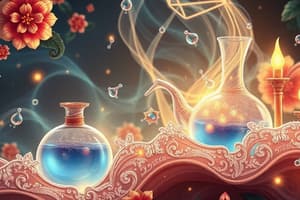Podcast
Questions and Answers
What happens to the temperature of boiling liquid during the phase change?
What happens to the temperature of boiling liquid during the phase change?
- It increases
- It remains constant (correct)
- It decreases
- It fluctuates
At what temperature can a gas no longer be liquefied?
At what temperature can a gas no longer be liquefied?
- 0℃
- 31.1℃ (correct)
- 73 atm
- -56.4℃
What type of solution contains more dissolved solute than typically possible at room temperature?
What type of solution contains more dissolved solute than typically possible at room temperature?
- Saturated
- Hyperconcentrated
- Unsaturated
- Supersaturated (correct)
What is the state of CO2 at -56.4℃?
What is the state of CO2 at -56.4℃?
Can a solution contain only one solvent and multiple solutes?
Can a solution contain only one solvent and multiple solutes?
Why does water form a spherical droplet shape at the top of a coin?
Why does water form a spherical droplet shape at the top of a coin?
What is vapor pressure?
What is vapor pressure?
How does vapor pressure relate to boiling point?
How does vapor pressure relate to boiling point?
Why does rubbing alcohol feel cold when applied to the skin, even if it's warmed to body temperature?
Why does rubbing alcohol feel cold when applied to the skin, even if it's warmed to body temperature?
Why does the temperature of a boiling liquid remain constant even with continuous heat input?
Why does the temperature of a boiling liquid remain constant even with continuous heat input?
Flashcards are hidden until you start studying
Study Notes
Phase Diagram
- The temperature of a boiling liquid remains constant because the added heat is used to convert the liquid into vapor.
- The temperature above which a gas can no longer be liquefied is called the critical point.
- The critical temperature and pressure of water are 374℃ and 218 atm, respectively.
Phase Diagram - CO2
- At a temperature of -56.4℃, CO2 is in its liquid state.
- The critical point of CO2 is 31.1℃ and 73 atm.
Solutions
- A solution can contain a single solvent and one or more solutes.
- Unsaturated solutions are those that can dissolve more solutes.
- Supersaturated solutions contain more dissolved solutes than what is typically possible at a given temperature.
- Saturated solutions are those that cannot dissolve any more solutes.
Intermolecular Forces of Attraction
- The possible IMF of a compound depend on the type of molecules involved:
- Compounds containing only C and H exhibit London dispersion forces (LDF).
- Compounds containing H and F, O, or N exhibit hydrogen bonding (H-bond), LDF, and dipole-dipole forces (D-D).
- Noble gases exhibit LDF.
- Diatomic elements such as I2, F2, Cl2 exhibit LDF.
- Polar compounds exhibit D-D and LDF.
- Nonpolar compounds exhibit LDF.
Properties of Liquids
- The cohesive force of water creates surface tension, causing it to form a spherical droplet shape.
- Vapor pressure is the characteristic of a liquid that is a function of its temperature.
- When a liquid vaporizes in a closed container, the space above the liquid becomes saturated with vapor, and an equilibrium exists between the liquid and the vapor.
- The relationship between vapor pressure and boiling point is inversely proportional.
- Rubbing alcohol feels cold when applied to the skin due to evaporative cooling.
- The temperature of a boiling liquid remains constant even when heat is continuously added because the added heat is used to convert the liquid into vapor.
Studying That Suits You
Use AI to generate personalized quizzes and flashcards to suit your learning preferences.




